I still remember my college days when my barkada and I would scrape together our last coins just to share a sizzling plate of Sisig Hooray after class. That crackling sound, the aroma, and fighting over who gets the last few spoonfuls, it was heaven on a hot plate for just ₱99!
But when the pandemic hit and I couldn't get my pork sisig fix, I was determined to recreate that same magic at home. After countless attempts (and a few charred mishaps), I've finally perfected this homemade pork sisig recipe that brings back those Sisig Hooray memories. But dare I say, tastes even better!
Once you nail this pork sisig recipe, your family will be requesting it every weekend, and your friends will be inventing reasons to "drop by" your house. It costs way less than restaurant sisig, and you can adjust the spice level exactly how you like it.
Ready to become your squad's unofficial sisig master?
Jump to:
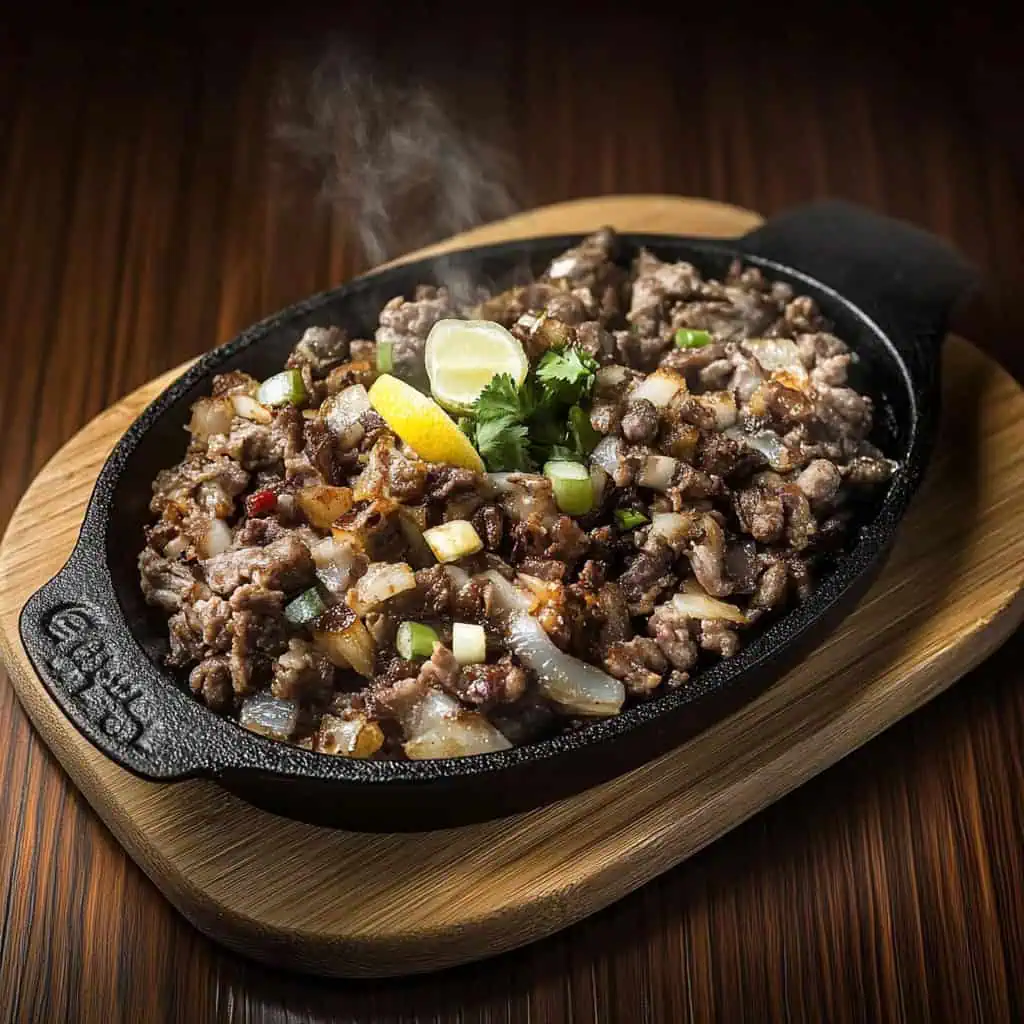
Why You'll Love This Recipe
- Perfect Texture Contrast: Experience the magical combination of crispy exterior and tender interior in every bite
- Restaurant-Quality Results: Learn the exact techniques used in famous sisig spots
- Complete Guide: From ingredient preparation to serving, nothing is left to chance
- Budget-Friendly: Transform affordable cuts into a premium dish
- Authentic Taste: Real Kapampangan-style recipe with modern conveniences
- Party Favorite: Guaranteed to be the star of any gathering or "inuman"
Ingredients
These ingredients form the core of authentic pork sisig, each playing a crucial role in creating its distinctive flavor and texture. The meat provides the dish's foundation and desired texture contrast, liver spread adds richness and depth, calamansi juice delivers essential brightness and acidity, Thai chilies bring customizable heat, Maggi seasoning contributes savory umami notes, and the sizzling plate creates the signature crispy exterior that defines great sisig.
With these essential elements covered, you can adapt the recipe while maintaining its authentic character.
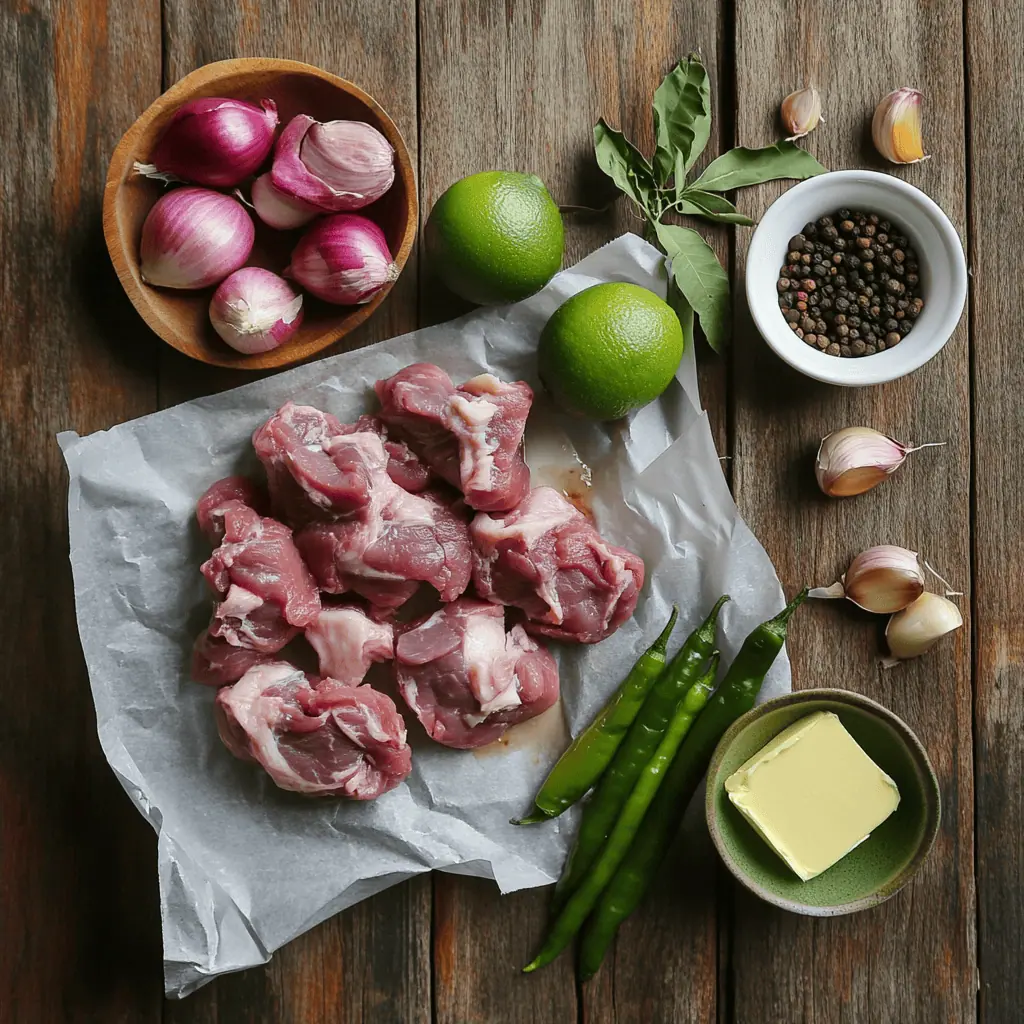
Main Ingredients:
- 2 pounds pig face (snouts, ears, and jowls)
- 1 large onion, finely diced
- 6 Thai chili peppers
- ½ cup liver spread
Boiling Liquid:
- 1 cup vinegar [Suka]
- ¼ cup soy sauce [Toyo]
- 1 head garlic, crushed
- 1 teaspoon whole peppercorns [Pamintang buo]
- 2 bay leaves [Dahon ng laurel]
- 1 tablespoon salt [Asin]
- Water, enough to cover the meat
Seasoning:
- ½ cup calamansi juice
- 1 tablespoon Liquid seasoning (Maggi)
- Salt and pepper to taste [Asin at paminta]
- 2 tablespoons butter for serving [Mantikilya]
- 1 fresh egg (optional) [Itlog]
Equipment
- Large Pot (Malaking kaldero) - For boiling the meat until tender; a heavy-bottomed pot helps maintain even heat distribution for consistent cooking.
- Chopping Board (Sangkalan) - A sturdy wooden or plastic board dedicated to meat preparation; preferably with a groove to catch juices during chopping.
- Sharp Knife (Matalas na kutsilyo) - Essential for efficiently chopping the cooked meat into small, uniform pieces; a cleaver works particularly well for this task.
- Sizzling Plate - The signature serving vessel that creates the distinctive crackling sound and continues cooking the meat; cast iron plates retain heat longer for the best effect.
- Tongs - Helps safely handle and flip the meat during grilling and when transferring to the sizzling plate.
- Strainer (Salaan) - For draining the boiled meat thoroughly, which is crucial for achieving the right texture during grilling.
- Meat Thermometer - Ensures the meat reaches safe internal temperatures (75°C/165°F) while preventing overcooking.
- Grill or Broiler - Creates the essential char marks and crispy edges that give sisig its signature texture.
- Heavy-Duty Mixing Bowl - For combining all ingredients before transferring to the sizzling plate.
- Citrus Juicer - Makes extracting fresh calamansi juice efficient and maximizes the yield.
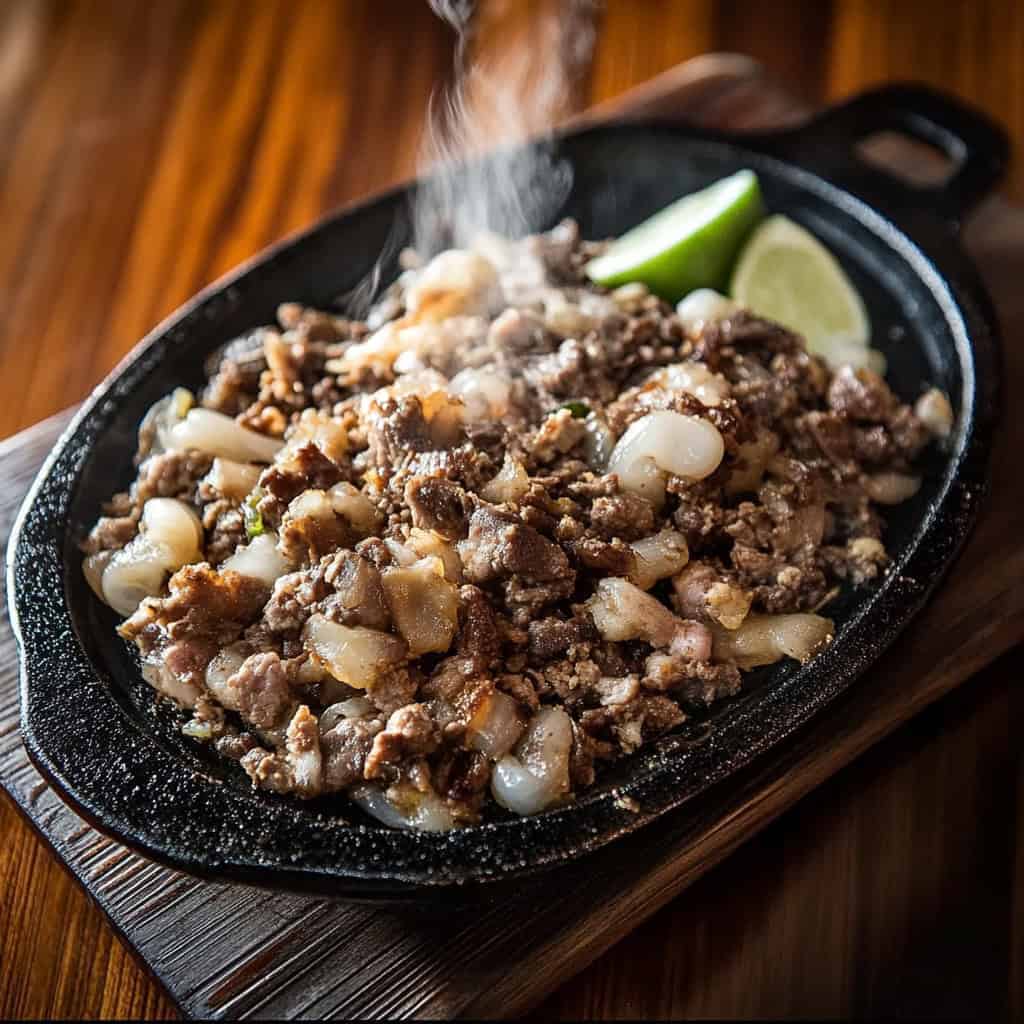
How To Make
Preparation Phase (30 minutes)
- Begin by thoroughly cleaning all meat parts under cold running water. Pay special attention to the ears, removing any wax or debris. Pat the meat dry with paper towels.
- Fill a large pot with enough water to fully submerge the meat. Add 1 cup vinegar (suka), crushed garlic (dinurog na bawang), bay leaves (dahon ng laurel), whole peppercorns (pamintang buo), soy sauce, and salt (asin). Bring this mixture to a full boil over high heat until it reaches 180°C/350°F.
- Add the cleaned meat to the boiling liquid. Once the water returns to a boil, reduce the heat to medium-low, maintaining a temperature of 140°C/285°F. Cover the pot and let the meat simmer for 45-60 minutes until tender (hanggang lumambot). You should be able to easily pierce the meat with a fork (dapat madaling tusukin ng tinidor). The internal temperature should reach 75°C/165°F.
- While waiting, prepare your other ingredients. Finely chop the white onions (tadtarin ng pino ang sibuyas), green chilies, and set aside. Squeeze fresh calamansi to get the juice (pigain ang kalamansi) and prepare your seasonings.
Grilling Phase (20 minutes)
- Once the meat is tender, remove it from the pot and let it drain in a colander (salaan). Allow it to cool slightly for about 10 minutes. Heat your grill or broiler to 230°C/450°F during this time.
- Place the boiled meat on the hot grill or under the broiler. Grill each side for 7-10 minutes until you achieve a nice char. The edges should be dark brown and slightly crispy. Maintain the internal temperature at 75°C/165°F.
- Remove the grilled meat from heat and let it rest for 5-10 minutes until cool enough to handle.
Assembly Phase (15 minutes)
- Using a sharp knife, chop the meat into very small pieces, about 0.5cm x 0.5cm in size (tadtaring mabuti ang karne). Leave some slightly larger pieces for texture variation. This step is crucial for authentic sisig texture.
- Heat your sizzling plate to 200°C/400°F. While the plate is heating, combine your chopped meat in a large bowl with the finely diced onions, chopped chilies, and liver spread. Season with calamansi juice, Maggi seasoning (toyo), and salt and pepper to taste (timplahan ng asin at paminta). Mix thoroughly but gently.
- Once the sizzling plate is very hot, add butter (mantikilya) and let it melt. Immediately add your meat mixture to the plate. The bottom layer will create a delicious crust as it continues to cook. Spread the mixture evenly across the plate.
- Just before serving, crack a fresh raw egg on top of the sizzling mixture. Serve immediately while the plate is still sizzling hot .

Tips from Lola's Kitchen
- Meat Preparation: For tenderer meat, boil it the night before and refrigerate. This allows the flavors to develop more deeply.
- Flavor Complexity: Use a mix of vinegar and calamansi for more complex sourness that balances the richness.
- Texture Secret: Chop ingredients uniformly for better texture, but leave some slightly larger pieces for variety.
- Sizzling Plate Technique: Let the bottom create a crust on the sizzling plate before stirring for the perfect texture contrast.
- Temperature Management: Keep your sizzling plate extremely hot before adding the mixture for that authentic restaurant-style sizzle.
- Aromatics: Add a small amount of minced lemongrass to the boiling liquid for a subtle citrus aroma.
- Timing: The entire dish should come together quickly once the meat is prepared - have all ingredients ready before the final assembly.
- Presentation: Serve immediately after adding the egg. The drama of the sizzling plate is part of the experience.
Substitutions
- Sizzling Plate: Cast iron skillet (preheated), heavy frying pan, or grill pan
- Pig Face/Ears/Jowls (2 pounds): Pork belly (cut in 1-inch cubes), pork shoulder, chicken thighs, or extra-firm tofu + mushrooms for vegetarian option
- Liver Spread (½ cup): Grilled and mashed chicken livers (¼ cup), any liver pâté (½ cup), puréed black beans with smoked paprika (½ cup), or mayonnaise (¼ cup)
- Calamansi Juice (½ cup): Lime + lemon juice mix (6 tablespoon lime + 2 tablespoon lemon), lime juice only (½ cup), or lemon juice (½ cup) with a pinch of sugar
- Thai Chili Peppers (6): Serrano peppers (3-4), jalapeños (4-5), bird's eye chili (3), or red pepper flakes (1-2 tsp)
- Maggi Seasoning (1 tbsp): Knorr liquid seasoning (1 tbsp), soy sauce + Worcestershire (2 teaspoon + 1 tsp), or Bragg's Liquid Aminos (1 tbsp)
Troubleshooting
Too Dry?
Problem: Sisig lacks moisture and seems too dry. Solution: Add more liver spread (1-2 tablespoons) and a splash of chicken broth or beer. Mix well and let it continue cooking on the sizzling plate.
Too Salty?
Problem: The seasoning is overpowering with saltiness. Solution: Balance with additional calamansi juice (1-2 tablespoons) and a small amount of sugar (½ teaspoon) to counteract the saltiness.
Not Crispy Enough?
Problem: The meat lacks the crispy texture characteristic of good sisig. Solution: Use higher heat on the sizzling plate and ensure the meat is properly dried after boiling. You can also briefly return the chopped meat to the grill or broiler for additional crisping.
Too Spicy?
Problem: The heat level is overwhelming. Solution: Add more onions and a tablespoon of mayonnaise to dilute the spiciness. Serve with a side of rice to help balance the heat.
Too Sour?
Problem: The calamansi or vinegar flavor is too pronounced. Solution: Add a tablespoon of butter and a pinch of sugar to balance the acidity. You can also add a bit more liver spread for richness.
Meat Too Tough?
Problem: The meat pieces are difficult to chew. Solution: Return the mixture to a pot with a small amount of broth and simmer covered for 15-20 minutes, then transfer back to a sizzling plate.
Storage & Reheating
Refrigeration
- Store leftover sisig in an airtight container in the refrigerator for up to 3 days.
- Separate the sisig from any raw egg portions before storing.
- For best results, store the basic mixture separately from any garnishes or toppings.
Freezing
- Sisig can be frozen for up to 2 months in freezer-safe containers.
- Divide into portion-sized containers for easier reheating.
- Label with the date and contents for easy identification.
- Thaw overnight in the refrigerator before reheating.
Reheating
- Best Method: Use a sizzling plate heated to 180°C/350°F and add a small amount of fresh butter to restore the original texture.
- Stovetop Alternative: Heat a heavy skillet until very hot, add a small amount of oil, and stir-fry the sisig until heated through and slightly crispy again.
- Oven Method: Spread in a thin layer on a baking sheet and heat at 180°C/350°F for 7-10 minutes until hot and edges are crispy.
- Avoid Microwave: While convenient, microwave reheating will make the sisig soggy and change the texture significantly.
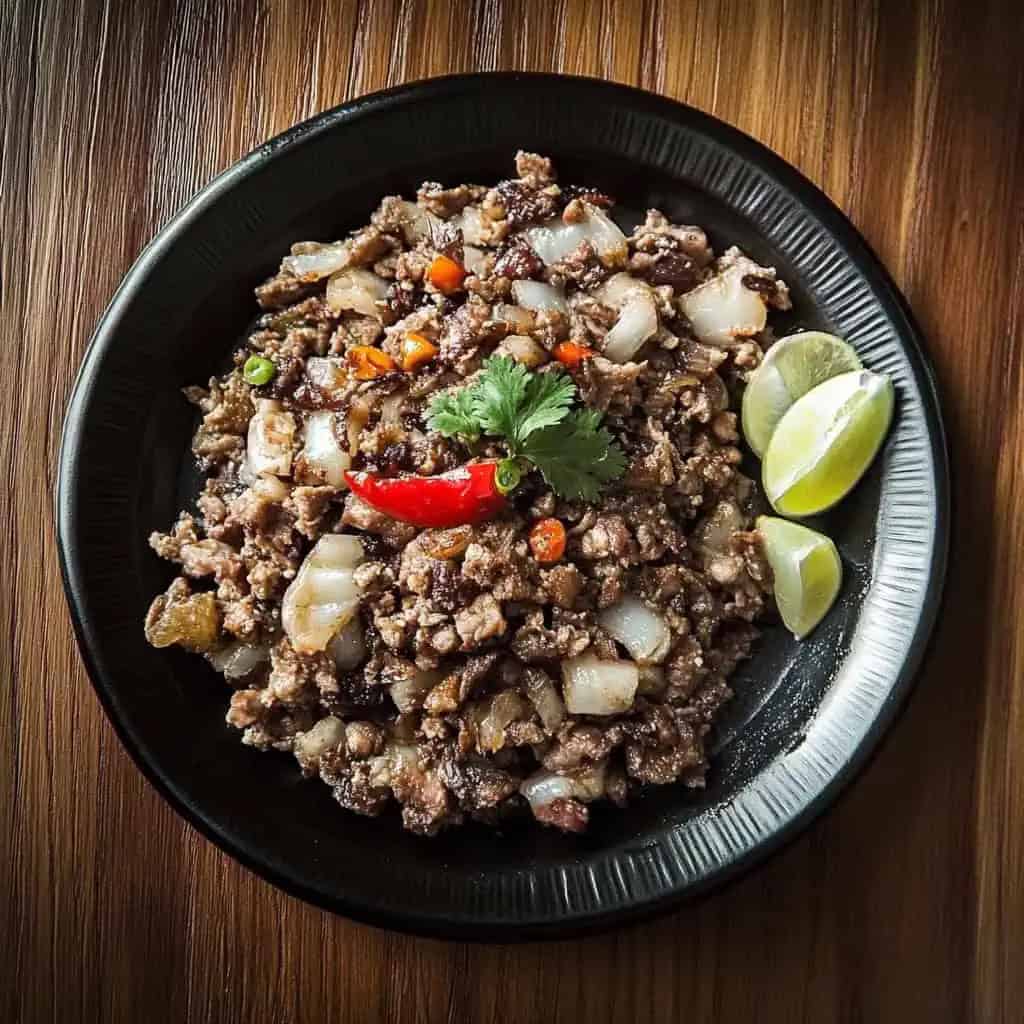
FAQ
Can I make sisig ahead of time?
Yes! Prepare up to step 8 (chopping the grilled meat) a day in advance. Store the chopped meat mixture in the refrigerator, then complete the final assembly and heating just before serving. This makes it perfect for parties where you want to minimize last-minute cooking.
Is authentic sisig always spicy?
Traditional sisig has a mild to medium heat level, but the spiciness is completely adjustable. You can reduce or increase the number of Thai chilies based on your preference. Many authentic versions allow diners to add their own hot sauce or chili vinegar at the table.
How do I know when the meat is tender enough during boiling?
The meat should be fork-tender, meaning you can easily pierce it with a fork without resistance. The ears might take longer than other parts to become tender. If you're unsure, continue cooking for another 10-15 minutes, checking periodically. A meat thermometer should read 75°C/165°F.
Can I use just one type of pork cut instead of the traditional mix?
Yes, though the mix of textures is what makes traditional sisig special. If using just one cut, pork belly (liempo) offers the best results because it has both meat and fat content. You'll lose some of the gelatinous quality that ears provide, but it will still be delicious.
Why is the sizzling plate so important?
The sizzling plate serves three crucial functions: it creates a crispy bottom layer as the mixture continues to cook, it keeps the dish hot throughout the meal, and it provides the dramatic presentation that's part of the sisig experience. The continuing cook on the hot plate develops flavor and improves texture.
Can I make sisig without liver spread?
Yes, though it adds significant richness and binding properties. Traditional sisig actually used grilled and mashed chicken liver instead of commercial liver spread. You can mash ¼ cup of grilled chicken livers as a substitute, or omit it entirely and add a bit more butter for richness.
What's the best way to serve sisig for a party?
For larger gatherings, prepare multiple smaller batches rather than one large portion. Use several small sizzling plates or individual serving-sized plates. This maintains the proper texture and temperature, and creates a more interactive dining experience. Have garnishes like extra calamansi, eggs, and chilies available for guests to customize their portions.
Can I use this recipe for other meats like beef or lamb?
Yes, the technique works well with most meats. For beef, use cheaper cuts like chuck or brisket and increase the boiling time by 30-45 minutes. For lamb, shoulder meat works best. Adjust seasoning as needed, as these meats have stronger flavors than pork.
What drinks pair best with sisig?
Cold beer is the traditional pairing, particularly Filipino lagers like San Miguel. For non-alcoholic options, try calamansi juice with soda water, or coconut water which balances the richness of the dish.
Is it safe to eat the raw egg on top?
The traditional raw egg is meant to cook slightly from the heat of the sizzling plate. If you're concerned about food safety, you can either omit the egg entirely, use pasteurized eggs, or add the egg earlier in the process to ensure it cooks thoroughly.
Related
Looking for other recipes like this? Try these:
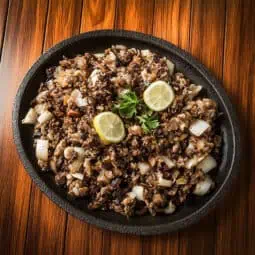
Pinoy Pork Sisig
Equipment
- Large pot [Malaking kaldero]
- Chopping board [Tabla]
- Sharp knife [Matalas na kutsilyo]
- Sizzling plate
- Tongs [Sipit]
- Strainer [Salaan]
Ingredients
Main Ingredients:
- 2 pounds pig face snouts, ears, and jowls [Mukha ng baboy (ilong, tainga, at pisngi)]
- 1 large onion finely diced [Malaking sibuyas, tinadtad]
- 6 Thai chili peppers [Siling pangsigang]
- ½ cup liver spread [Liver spread]
Boiling Liquid:
- 1 cup vinegar [Suka]
- ¼ cup soy sauce [Toyo]
- 1 head garlic crushed [Isang ulo ng bawang, dinurog]
- 1 teaspoon whole peppercorns [Pamintang buo]
- 2 bay leaves [Dahon ng laurel]
- 1 tablespoon salt [Asin]
- Water [Tubig]
Seasoning:
- ½ cup calamansi juice [Katas ng kalamansi]
- 1 tablespoon Liquid seasoning Maggi [Pampalasa]
- Salt and pepper to taste [Asin at paminta]
- Butter for serving [Mantikilya]
Instructions
- Begin by thoroughly cleaning all meat parts under cold running water (Hugasang mabuti ang karne sa malamig na tubig). Pat the meat dry with paper towels (Patuyuin gamit ang paper towel).
- Fill a large pot with water and add 1 cup vinegar (suka), crushed garlic (dinurog na bawang), bay leaves (dahon ng laurel), whole peppercorns (pamintang buo), and salt (asin). Bring this mixture to a full boil over high heat until it reaches 180°C/350°F.
- Add the cleaned meat to the boiling liquid. Once the water returns to a boil, reduce the heat to medium-low, maintaining a temperature of 140°C/285°F. Cover the pot and let the meat simmer for 45-60 minutes until tender (hanggang lumambot). You should be able to easily pierce the meat with a fork (dapat madaling tusukin ng tinidor). The internal temperature should reach 75°C/165°F.
- While waiting, prepare your other ingredients. Finely chop the white onions (tadtarin ng pino ang sibuyas), green chilies (siling pangsigang), and set aside. Squeeze fresh calamansi to get the juice (pigain ang kalamansi) and prepare your seasonings.
- Once the meat is tender, remove it from the pot and let it drain in a colander (salaan). Allow it to cool slightly for about 10 minutes. Heat your grill or broiler to 230°C/450°F during this time.
- Place the boiled meat on the hot grill or under the broiler. Grill each side for 7-10 minutes until you achieve a nice char (hanggang magkaroon ng burnt marks). The edges should be dark brown and slightly crispy. Maintain the internal temperature at 75°C/165°F.
- Remove the grilled meat from heat and let it rest for 5-10 minutes until cool enough to handle (hanggang makapag-tadtad). Using a sharp knife, chop the meat into very small pieces, about 0.5cm x 0.5cm in size (tadtaring mabuti ang karne). Leave some slightly larger pieces for texture variation.
- Heat your sizzling plate to 200°C/400°F. While the plate is heating, combine your chopped meat in a large bowl with the finely diced onions, chopped chilies, and liver spread. Season with calamansi juice, soy sauce (toyo), and salt and pepper to taste (timplahan ng asin at paminta).
- Once the sizzling plate is very hot, add butter (mantikilya) and let it melt. Immediately add your meat mixture to the plate. The bottom layer will create a delicious crust as it continues to cook. Spread the mixture evenly across the plate.
- Just before serving, crack a fresh raw egg (hilaw na itlog) on top of the sizzling mixture. Serve immediately while the plate is still sizzling hot (habang umuusok pa).
- For leftover sisig, store in an airtight container in the refrigerator for up to 3 days. When reheating, use a sizzling plate heated to 180°C/350°F and add a small amount of fresh butter to restore the original texture.
- Note: Sisig should be enjoyed fresh and hot. Once reheated, the texture changes slightly but the flavors remain delicious. Always ensure the egg is fresh and high-quality for the best results.
Tips from Lola's Kitchen
- For tenderer meat, boil it the night before
- Use a mix of vinegar and calamansi for more complex sourness
- Add butter to the sizzling plate for extra flavor
- Chop ingredients uniformly for better texture
- Let the bottom create a crust on the sizzling plate
Nutrition
The Story Behind Pinoy Pork Sisig
In the culinary landscape of Filipino cuisine, few dishes have achieved the legendary status of pork sisig. Born in the streets of Angeles City, Pampanga – the Philippines' culinary capital – this sizzling sensation started not as the beloved pulutan (beer match) we know today, but as a humble solution to prevent food waste in the 1970s.
The story begins at Clark Air Base during the American occupation, where surplus pig heads from commissaries were sold at bargain prices to local Filipinos. Enter Lucia Cunanan, affectionately known as "Aling Lucing," who would later be crowned the "Sisig Queen." She saw potential in these discarded cuts and transformed them into something extraordinary. By boiling pig ears and face, chopping them finely, and serving them with a tangy calamansi dressing, she created the original sisig.
But it was her stroke of genius – serving the chopped meat on a sizzling plate – that revolutionized the dish. The hot plate continues cooking the meat, creating those coveted crispy bits while keeping the dish warm throughout the meal. This innovation turned a simple street food into a theatrical dining experience, with the dramatic sizzle and the melting egg creating an irresistible show at the table.
Today, sisig has evolved far beyond its origins. From humble carinderias to high-end restaurants, chefs have created countless variations using chicken, seafood, and even tofu. The late Anthony Bourdain famously praised it as the perfect beer food, introducing it to a global audience. Yet despite its modern interpretations, traditional Kapampangan sisig remains distinctly special – no mayonnaise, just the pure flavors of perfectly prepared pork enhanced by calamansi, onions, and chilies.
What makes sisig truly remarkable is how it embodies Filipino culinary ingenuity. It's a testament to our ability to transform simple ingredients into something extraordinary, a dish that tells the story of resourcefulness, creativity, and the elevation of street food to culinary art. Whether enjoyed as a main dish with rice or as the ultimate pulutan with ice-cold beer, sisig continues to bring people together, creating memories one sizzling plate at a time.
This humble dish has become so significant that Angeles City now celebrates the Sisig Festival, honoring both the dish and Aling Lucing's legacy. It's even earned a spot in the global culinary scene, with food critics and chefs worldwide recognizing it as one of the Philippines' greatest contributions to world cuisine.
From pig face to culinary grace, sisig's journey represents everything special about Filipino food – our ability to take humble ingredients and, through patience, skill, and creativity, transform them into something truly unforgettable. Every plate of sisig serves not just a meal, but a piece of Filipino culinary history, sizzling with pride and packed with flavor.
Remember: The mark of perfect sisig isn't in fancy plating or modern twists—it's in achieving that perfect balance of crispy and tender, tangy and savory, all served on a sizzling plate that continues to cook the dish as you eat.
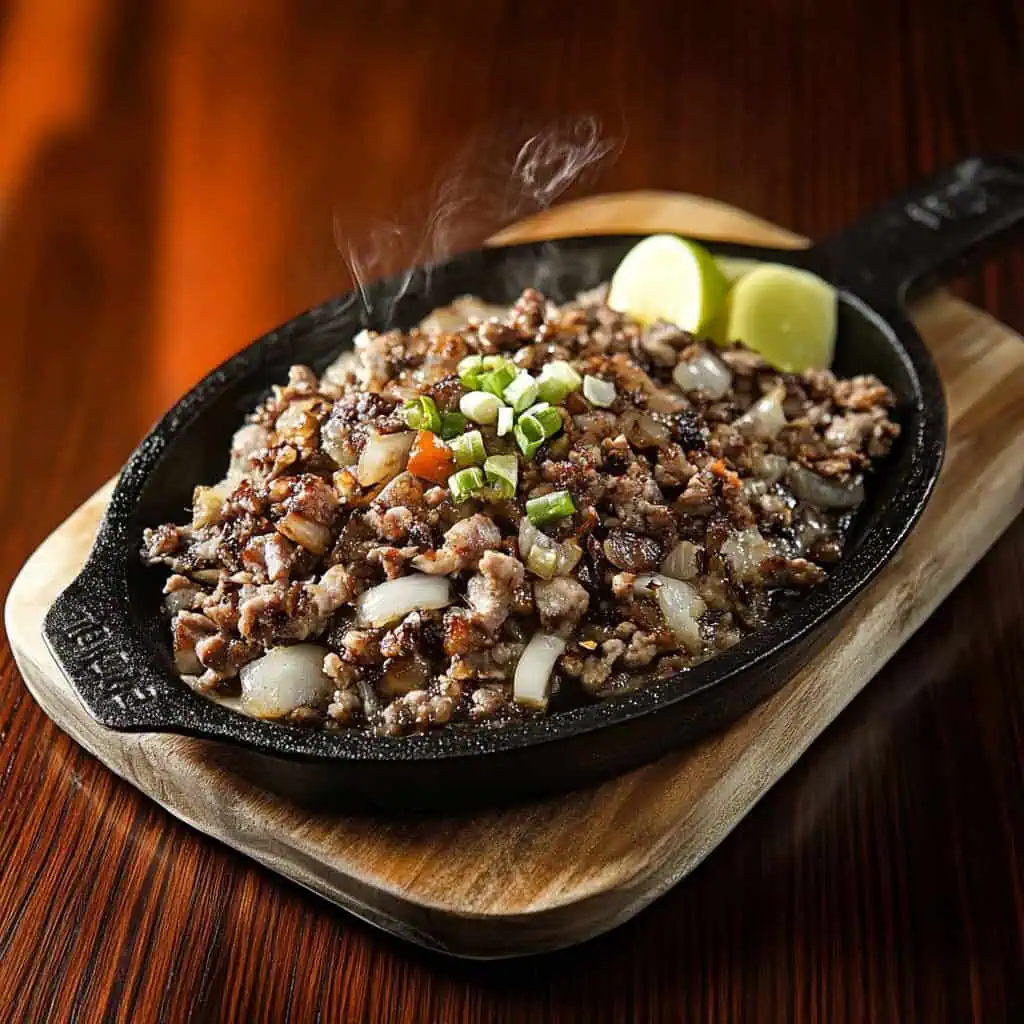









Comments
No Comments